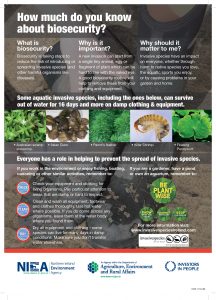Four priority areas to advance invasion science in the face of rapid environmental change
 Unprecedented rates of introduction and spread of non-native species pose burgeoning challenges to biodiversity, natural resource management, regional economies, and human health. Current biosecurity efforts are failing to keep pace with globalization, revealing critical gaps in our understanding and response to invasions. This study identifies four priority areas to advance invasion science in the face of rapid global environmental change;
Unprecedented rates of introduction and spread of non-native species pose burgeoning challenges to biodiversity, natural resource management, regional economies, and human health. Current biosecurity efforts are failing to keep pace with globalization, revealing critical gaps in our understanding and response to invasions. This study identifies four priority areas to advance invasion science in the face of rapid global environmental change;
-
-
-
- Invasion science should strive to develop a more comprehensive framework for predicting how the behavior, abundance, and interspecific interactions of non-native species vary in relation to conditions in receiving environments and how these factors govern the ecological impacts of invasion.
- Understand the potential synergistic effects of multiple co-occurring stressors— particularly involving climate change—on the establishment and impact of non-native species. Climate adaptation and mitigation strategies will need to consider the possible consequences of promoting non-native species, and appropriate management responses to non-native species will need to be developed.
- Address the taxonomic impediment. The ability to detect and evaluate invasion risks is compromised by a growing deficit in taxonomic expertise, which cannot be adequately compensated by new molecular technologies alone. Management of biosecurity risks will become increasingly challenging unless academia, industry, and governments train and employ new personnel in taxonomy and systematics.
- Internationally cooperative biosecurity strategies should consider the bridgehead effects of global dispersal networks, in which organisms tend to invade new regions from locations where they have already established. Cooperation among countries to eradicate or control species established in bridgehead regions should yield greater benefit than independent attempts by individual countries to exclude these species from arriving and establishing.
Ricciardi, A., Iacarella, J.C., Aldridge, D.C., Blackburn, T.M., Carlton, J.T., Catford, J.A., Dick, J.T.A., Hulme, P.E., Jeschke, J.M., Liebhold, A.M., Lockwood, J.L., MacIsaac, H.J., Meyerson, L.A., Pyšek, P., Richardson, D.M., Ruiz, G.M., Simberloff, D., Vilà, M. and Wardle, D.A. (2020). Four priority areas to advance invasion science in the face of rapid environmental change. Environmental Reviews, pp.1–23.
Go to article…
 Unprecedented rates of introduction and spread of non-native species pose burgeoning challenges to biodiversity, natural resource management, regional economies, and human health. Current biosecurity efforts are failing to keep pace with globalization, revealing critical gaps in our understanding and response to invasions. This study identifies four priority areas to advance invasion science in the face of rapid global environmental change;
Unprecedented rates of introduction and spread of non-native species pose burgeoning challenges to biodiversity, natural resource management, regional economies, and human health. Current biosecurity efforts are failing to keep pace with globalization, revealing critical gaps in our understanding and response to invasions. This study identifies four priority areas to advance invasion science in the face of rapid global environmental change;